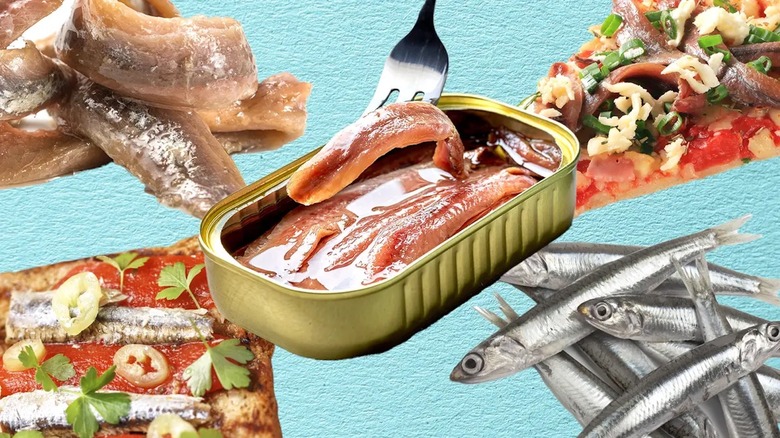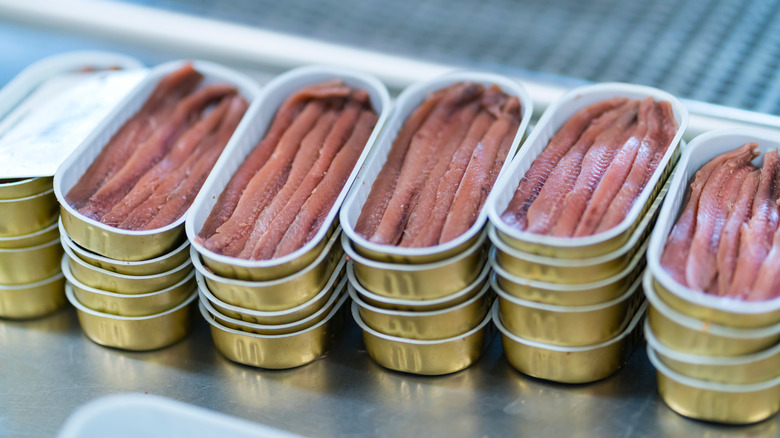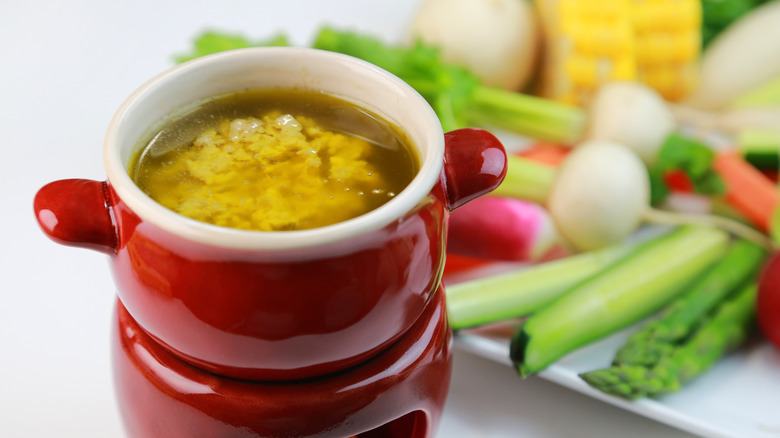The Ultimate Guide To Anchovies
Anchovies have been the butt of many culinary jokes. This is despite the fish having been enjoyed for hundreds of years, especially in Europe. While popular around the Mediterranean, anchovies have struggled to break into the American market; the fish was even named the country's least favorite pizza topping.
It is generally thought that the American aversion to anchovies is rooted in a historical lack of quality products. Fortunately, lack of access is no longer an issue; industry-leading brands such as Ortiz are now available worldwide. Add to this anchovies' many purported health benefits, attractively retro packaging, and affordable price points and it's not hard to see why anchovies are beginning to have their moment stateside.
With Americans finally waking up to the fact that anchovies are versatile and immensely flavorful fish, we have collected everything you need to know about them. The only question now is when will you start putting anchovies on your pizza?
What are anchovies?
Anchovy is an umbrella term for a variety of fish species from the Engraulidae family. All these fish are small filter feeders — usually between four to 10 inches long — and are found in oceans and brackish water around the world. Although rarer, there are also some species of anchovy that live in freshwater. All anchovies are classified as oily fish because they are high in omega-3 fatty acids. Such a high concentration of oil is due to anchovies being incredibly active animals; the fatty acid is used by their bodies as fuel.
The best quality anchovies are thought to be European anchovies, which are caught across the continent. Of these stocks, those found in the Cantabrian Sea are deemed the ultimate, although those around the Mediterranean are also very good. Traditionally processed then canned or jarred, these anchovies have long formed an important part of European diets. In comparison, Northern anchovies found off the Pacific coast of North America, remain largely unpopular. These fish are predominantly used as bait fish or are ground into meal. Americans, it seems, prefer to import and eat European anchovies as opposed to ones native to the continent.
How are anchovies processed?
The first step in processing anchovies is catching them. Anchovies in the waters around Europe and North America are usually caught using purse seines, a type of vertical net. Thanks to limited bycatch and no contact with the seabed, purse seine fishing is seen as a relatively sustainable method. Other methods, including the ancient and ultra-sustainable menaica net, are used in some fisheries.
After being caught, the fish must be processed quickly; the high levels of omega-3 fatty acid in their flesh means they can spoil rapidly. Processing begins with the beheading and gutting of the fish. The cleaned carcasses are then packed in salt and occasionally pressed. This dehydrates the fish. A reduction in water levels and increased concentrations of salt preserves the fish by creating an environment that many microorganisms cannot tolerate, as per The Journal of Food Science and Technology. This curing period can last anywhere between a few months and a year.
When complete, the anchovies are soaked and dried to remove excess salt. They are then fileted and the spine discarded. Finally, the filets are packed into jars or tins, filled with oil and sealed, resulting in the oil-packed anchovies many Americans will be familiar with. Salt-packed anchovies — which are less common although still prevalent — are packed into cans and jars, along with an intensely salty brine, once the curing process is complete. As such, consumers must rinse and filet these anchovies themselves.
Anchovies vs. sardines
As two types of small, oily fish that are frequently sold in cans, anchovies and sardines are often confused with one another. However, the two fish are completely distinct and have different culinary uses. One of the primary causes of this is how the two fish are processed. As previously mentioned, anchovies — if not eaten fresh — are usually salt-cured. This gives them their characteristically intense flavor. On the other hand, preserved sardines are canned in spring water or olive oil with no curing taking place. While still flavorful and distinctly fishy, sardines do not pack the powerful punch that anchovies do. Of course, this means anchovies should not be substituted for sardines and vice versa.
Packed bones and all, sardines are often enjoyed whole. Their meaty texture and delicate flavor makes this an extremely enjoyable experience. Furthermore, sardines are bigger than anchovies making them better suited to platters and for use as prominent ingredients in dishes like pasta. That being said, anchovies are far superior at lending flavor to other ingredients. Quite often, anchovies are used as a "hidden ingredient," dissolved in sauces to lend a significant punch of umami, something sardines could never do.
While predominantly similar in a nutritional sense, anchovies frequently have a much higher sodium content than sardines due to the salt-curing process. This means that those with hypertension should limit their intake of anchovies. Thankfully, they can still enjoy numerous sardines.
Are anchovies sustainable?
As with all fish the sustainability of anchovies is dependent on a large variety of factors. These include where the fish were caught, the methods that were employed, and which fishery they come from. Generally, European anchovies are deemed a sustainable choice, this being due to robust stocks, the fish's rapid maturation, and the purse seine method of fishing.
The picture only gets better when comparing anchovies to other fish. As a fish at the bottom of the food chain, anchovies have been labeled as the world's most carbon-efficient animal protein. Yet, the fish are still vulnerable to overfishing as was seen in the early 2000s when stocks in the Mediterranean plummeted. María Santos, a senior researcher on sustainable fisheries explains to Bloomberg: "We had been warning since 2001 that the anchovy population was falling sharply. Then in 2005 the fishermen went to sea and found nothing." Thankfully, careful management has seen these stocks replenished.
Fishery management is vital because, as well as feeding humans, anchovy populations act as a food source for a large variety of other fish and seabirds. Avoiding similar population declines in the future is of utmost importance lest decimated anchovy populations spell disaster for the entire marine food web. This was seen off the coast of California where collapsing anchovy stocks detrimentally affected predators from whales to sea lions.
What do anchovies taste like?
Fresh anchovies are largely unremarkable in terms of flavor. So, while the high oil content means they crisp well when cooking they garner little culinary attention. Cured anchovies are the opposite. Notorious for their intense flavor, these slithers of fish can be extremely polarizing. Detractors label them as overly salty while proponents laud the umami richness of anchovies.
When left uncooked and whole, cured anchovies are a challenge to eat in any meaningful quantity. This is because all cured anchovies are relatively salty. That being said, cured anchovies vary from brand to brand with differences in saltiness, firmness, and flavor all being apparent. Interestingly, these differences become insignificant when the anchovies are used in cooking processes.
The final defining quality of anchovies' flavor is an inherent fishiness which is due to the high volume of oil present within the animal's flesh. Again, this will vary from brand-to-brand but a good piece of advice is to avoid anchovies that smell or taste abnormally fishy. This is a sign that the fatty acids are oxidizing and the fish turning rancid.
How to cook with anchovies
Anchovies are usually used to add flavor to other ingredients. The fish are incredibly well-suited to this because the curing process breaks down some of the fish's proteins, so anchovies are easy to mash into a sauce and mixed into a variety of dressings. Caesar salad dressing is perhaps the most popular example.
Those looking for a gentle entry into the world of anchovies could do worse than making bagna cauda, a traditional Italian dip in which oil, butter, garlic, and anchovies are blended and heated together. The resulting liquid is rich in flavor. A transformative feature of any crudité appetizer.
Another popular use for cured anchovies in Italy is to use them to add flavor to pasta sauces, including a pasta puttanesca recipe. When added during the cooking process, the fish breaks down completely, infusing the whole sauce with a satiating note of umami. What's more, cooking also breaks down any bones that might have escaped the fileting process. Care should be taken to ensure the final dish does not end up overly seasoned. Additional salt should only be added once all anchovies have completely dissolved.
Where to buy anchovies
When it comes to the cured variety, anchovies are extremely easy to find. Jarred or canned varieties sit in the shelves of just about all grocery stores. You can usually find them alongside the racks of canned tuna and salmon. However, many of the best European brands may only be available in specialty European stores and markets such as Mercado Central in New York City.
Personal preference — and cooking method — will largely dictate which brand you enjoy most. As such, trying various brands is the only way for you to settle on a favorite, although the eponymous Ortiz brand is a fantastic place to start. If at a complete loss, it is helpful to ask for any caught in the Cantabrian sea. These will likely be of high quality. Cooking the anchovies negates the differences between brands, so you should save the more expensive, luxury brands for occasions when the cured anchovies will not be cooked.
Fresh anchovies, in comparison, are much more difficult to source. If you live in coastal areas where the fish are plentiful, like California, you may find Northern anchovies at the fishmongers. These are a sustainable option in comparison to other fish species. Just make sure to use them quickly as they, like all anchovies, are prone to rapid spoilage.
How to store anchovies
Once canned or jarred, anchovies are extremely non-perishable. Be that as it may, there are some general rules that will vastly increase their shelf life. Storing canned or jarred anchovies in a cool place is the most important step. This is because high temperatures — above 100 degrees Fahrenheit — can cause spoilage in both canned and jarred foods.
Once opened, cured anchovies can be kept for several months if the following steps are taken. Firstly, if canned, decant the remaining anchovies into another container; this prevents the metal from altering the anchovies' flavor. Cover the anchovies with oil, seal the container, and store in the fridge. The fish should last for several months if stored like this. Unused anchovies can also be frozen. However, few choose to bother with this option. This is because frozen anchovies only last for about three months, meaning storing in oil is both simpler and more effective.
Nutritional information about anchovies
Getting plenty of omega-3 fatty acids through your diet is vital as the body uses omega-3 to create hormones that regulate and control various aspects of the cardiovascular system. Humans cannot make omega-3 fatty acids themselves. Instead, they rely on dietary intake to meet their needs. As such, anchovies are vital to the body, benefiting it in numerous ways by reducing the risk of heart disease and stroke.
Anchovies are also a fantastic source of selenium, providing an adult's entire daily recommended intake in one six-ounce serving. Adequate levels of this nutrient have been linked with reducing the risk of developing cancers as well as preventing cancerous cells spreading from a tumor, as per Proceedings of the Nutrition Society. Furthermore, anchovies are also a good source of protein.
While anchovies both fresh and cured share these nutritional benefits, only the latter suffers from a significant drawback, sodium content. The same six-ounce serving that provides an adult's entire daily recommended intake of selenium can contain around 6000 milligrams of sodium. That's more than double an American adult's daily recommended intake, according to the CDC.
Other types of anchovies
There is one other type of anchovy that is commonly available: marinated. A typical Spanish delicacy — known as boquerones en vinagre — marinated or white anchovies are significantly milder. The fish are preserved by pickling in vinegar before being covered in oil. Because they do not undergo a curing process they are both pleasurable to eat whole and much lower in sodium.
As a pickled, milder fish boquerones have carved themselves a niche in Spain's tapas-eating culture. Here they are usually served alone or in the famous pintxo Gilda. Hailing from País Basco, Gilda is often labeled the original pintxo. Perfect in its simplicity, it is made from olives, guindilla peppers and boquerones combined on a toothpick. This type of dish plays to the boquerones strengths, by steering clear of any cooking process to which they — unlike cured anchovies — are ill-suited to.
Often sold in packets as opposed to cans and jars, boquerones can prove harder to find and more expensive to buy. If that's the case, you can try your hand at making your own. All you need is vinegar, oil, and access to fresh anchovies making this one an endeavor for coastal-dwelling Americans to try.










